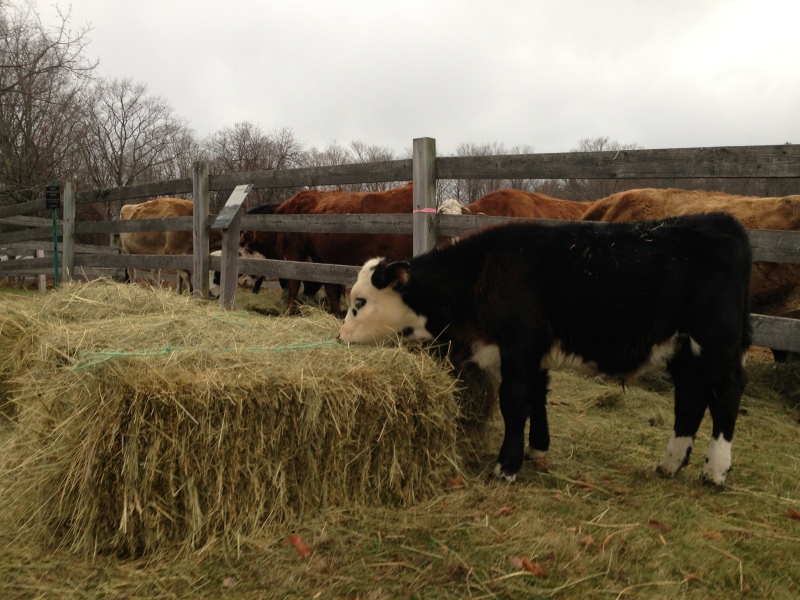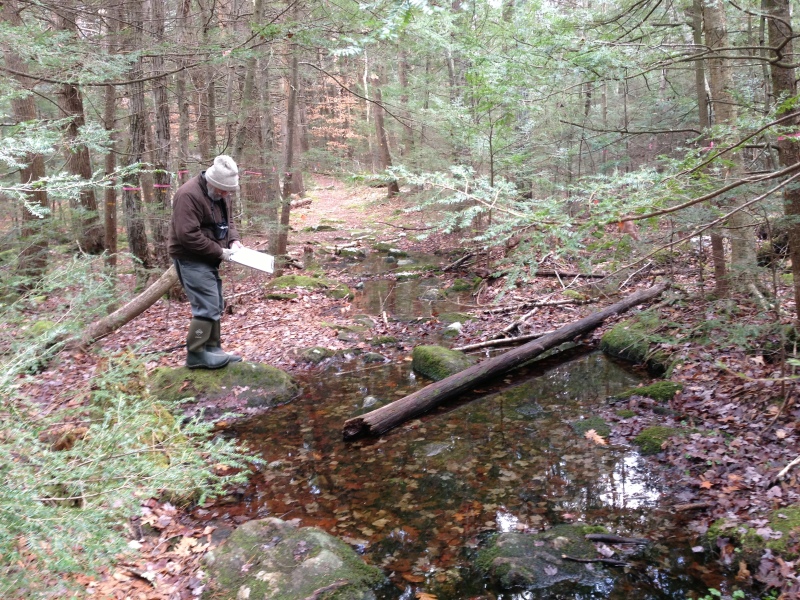WATER: THE VOICE OF HISTORY
I went out into the wood at midday to see what’s new. It’s warm here today, 45 degrees at noon, and overcast, with soft robin’s egg patches of blue breaking through the grey. The cows at the Sanderson Farm outside Community House where I live were snoozing in the south facing upper pasture. Norma, the bossiest, turned her head as she heard my door open, watching closely to see if I approached their fence. If knew if I did, they would all come over, looking for hamburger rolls or English muffins – their favorite treat. I walked on so as not to rouse them, aware Norma watched my every move as I passed along the edge of their pasture that fronts the Locust Opening Road, the main entrance to the Harvard Forest, closest to the parking lot.
The cows’ charisma is universal. Living here, I am aware of most visitors when they arrive and what they do. Invariably, as they head to the woods for a walk, or for research, they stop at the fence, and visit the cows. So popular are the cows that the Woods Crew had to post signs on their fence about the baby cow that likes to come under the lowest rail and take itself for walks and snack on fresh grass and the bales of hay waiting to be pitched over the fence for tomorrow’s breakfast. The sign assured visitors new to our little world here that the calf will take itself back inside the fence with the others on its own. “We were getting so many calls,” says John Wisnewski, head of the Woods Crew, and owner of our little herd.

One of two baby cows at the Harvard Forest helps himself to a snack while the rest of the herd looks on. The cows are so popular the Woods Crew had to post a sign assuring visitors the calf finds its way back under the fence when it’s good and ready to rejoin the others.
The cows are not only ambassadors for the forest, but a full time cast of historic re-enactors. With their sauntering gait and round the clock mowing, they not only keep open the pasture that would otherwise grow up into trees, but maintain and re-create the historic landscape of the John Sanderson Farm, here before Harvard purchased this land in 1907 for the Harvard Forest. This pasture today with its view of strolling cattle, stone walls and woods, is a deliberately recreated historic landscape, to show visitors what most of the New England landscape for many miles around would have looked like from about 1830-1880, the height of agricultural clearing in the region. The dioramas as the Fisher Museum at the Harvard Forest tell this story vividly.
Agriculture on these poor soils and small farms could not compete with the farms in the Midwest, once railroads and the Erie Canal opened markets to the populous markets of the East. Abandoned and grown back to trees, the former farmlands here are the forests we study at the Harvard Forest today.
Walking these woods today I see leaves still clinging to some of the oaks, but mainly it is the beeches that hang on, their leaves a bright toast color. Last week’s snow is melted in the south facing and open areas, but still heaped in the shadows and corners and canopied glades.
Moss on the stone walls and tree trunks is positively fluffy with the cool, moist weather, and the green of lichen, white pine and hemlock so lost in the foliage of the forest the rest of the year is vivid now. The white of paper birches is a clear bright note, a flute in the forest’s double bass brown, grey and wine color chords as we edge toward the winter solstice.
I realize as I walk and look that what is really before me is not one season, but four. Summer’s leaves on the ground, in fall repose, and spring’s buds clasped on winter’s bare twigs. Such a visible reminder of the seasonal procession that never stops, that we are privileged to see in our own brief moments in nature’s pageant, is a comfort. So are the rock walls and abandoned pasture gates and cellar holes I pass, reminders of our human seasons of use in this landscape, in an inextricably intertwined human and natural history.
The remnants of snow wear a pelted pattern drilled by falling drops of water from the high branches of sugar maples and oaks that line this portion of my daily, three-mile circuit in the wood. Leaves where the snow has receded are a rich, wine-dark brown; they aren’t the glossy, slippery dry scatter of just a few weeks ago that raised a ruckus of a rustle as I walked.
I see a lovely scatter of berries on the ground then feel embarrassed to realize they are the fruit of bittersweet, an invasive vine winding like an anaconda around a red maple. I remember I am not supposed to like it.
How the beech leaves blow, letting me see the wind, their flutter telling its speed and direction. But mostly, the leaves are off the trees now, and the snow gone from their branches, allowing me to see deep into the wood. And now, with the leaves off, there’s also this: the sweet sound of running water, returned to the wood.
The amount of surface water greatly increases in the forest once the trees go dormant. The melted snow, the rain, and the groundwater instead of being taken up by the trees for photosynthesis and passed into the air as water vapor, gathers in pools, puddles, trickles, rills, streams, and vernal pools. The vernal pool I watch through the seasons with John O’Keefe, Harvard Forest’s field phenologist, is filled brim full today. Its white ice is melted at the edges, where the transition from frozen water to liquid is as soft and hard to discern as the edge of a cloud.

The vernal pool on my walk has been brim full since late fall, when I took this photo of ice just starting to form. The pool’s water level is driven largely by the seasonal cycle of the forest.
The seasonality of the water level in this pool is what makes it a vital habitat for amphibians. Unable to support fish, it’s just the place for tadpoles of wood frogs to rear, metamorphosing to their terrestrial state before the pool dries out in summer. These still, clear waters are alive with the odd, quacking sounds of breeding wood frogs as soon as the first margin of meltwater shows in this pool. It’s an important, brief season of life entirely dependent on the water cycle cranked by the forest.
Seeing and hearing all this water around me now is a reminder of just how much moisture the trees soak up when they are at work. The path I walk through the hemlock wood is awash in puddles; usually I can hop rocks through here, but today I must pass deep into the wood beyond the path.
On the Prospect Hill Road, a stream winds downhill to the upper pasture as I head back toward the house. The cows know this stream well, after a dry spell, they will head to it for it to drink when it rains, passing up their water tank. Perhaps it tastes better, or they just like the change.
The view and sounds of all this water I enjoy today is a seasonal pleasure – but also a look and listen back to the history of this landscape. Back when all the trees I walk through today were cut for pasture and crops, the streams ran big enough to turn mills. That’s hard to imagine today, when the forests are using the water. But what we take for reality is just today’s version of this forest.

John O’Keefe, field phenologist at the Harvard Forest, notes how high the water level has risen at a seep on the path we walk, as the trees shut down for winter.
Not long ago, these streams ran hard enough year-round to turn millstones crushing tannin-rich hemlock bark, to steep with hides in water-filled vats, processing them to leather. John Sanderson ran a tannery turning out some 1,000 hides a year on this land. Amid the trees grown up since, if you know where to look, you can find the olds vats and millstone of the Sanderson tannery.
Today, the mill is long gone, but in winter, that same stream runs high and full, and the woods are full of its sound. The dormant trees have released it from a spring and summer industry of their own, making wood from thin air.

Leave a Reply